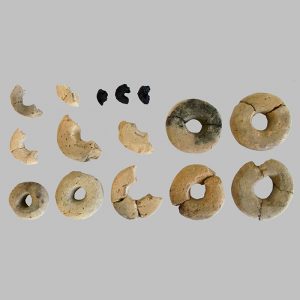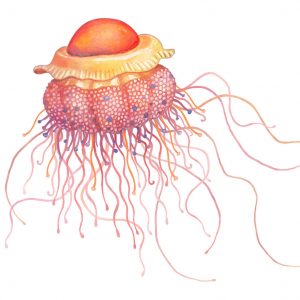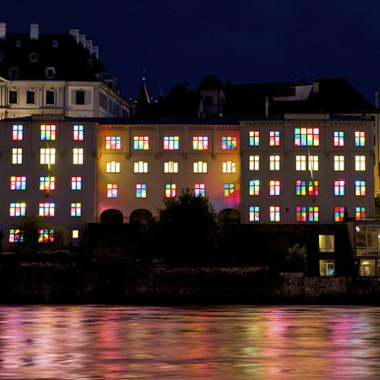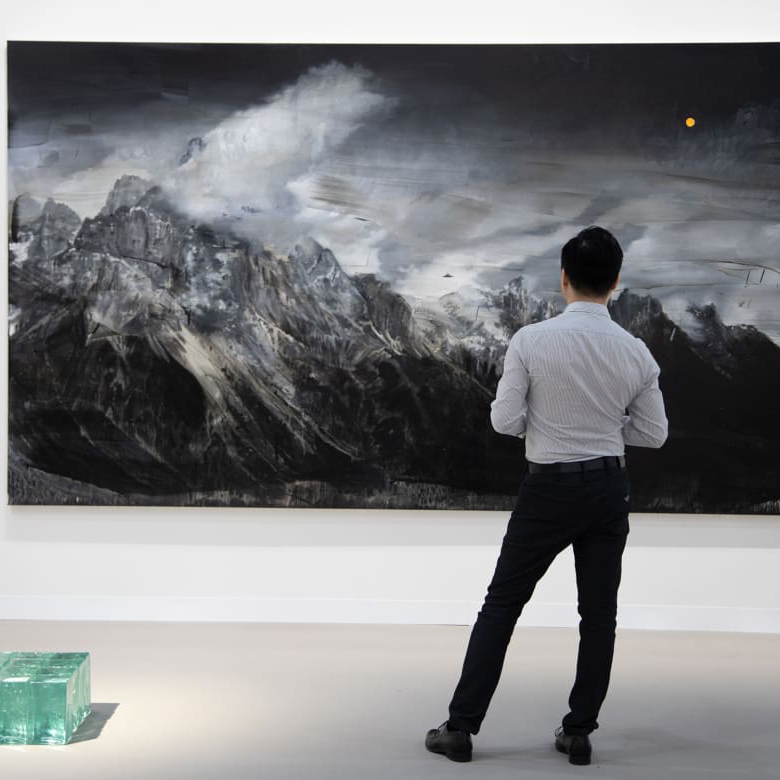Link About It: This Week’s Picks
An ambitious architectural project, strangely named animals, ancient marijuana-smoking and more from around the web

The State of the Art World According to Art Basel
 Despite there being nearly 300 art fairs globally, none come close to the prestige and forecasting power of Art Basel, currently in the midst of its 50th edition. The fair offers an opportunity to catch developments in the primary market, where art is sold by galleries for the first time (quite different than auction prices or other secondary market ones). This year, “The gallerists have answered the demand of the global and diverse market by focusing their supply on female artists and artists of color,” Dallas dealer Kristy Stubbs explains to the New York Times. This was evidenced by sales from everyone including NYC’s Jack Shainman to LA’s Freedman Fitzpatrick. Of course, mega-galleries also stuck to what they knew, offering up white male artists that fetch big prices. Read more about it all at the Times.
Despite there being nearly 300 art fairs globally, none come close to the prestige and forecasting power of Art Basel, currently in the midst of its 50th edition. The fair offers an opportunity to catch developments in the primary market, where art is sold by galleries for the first time (quite different than auction prices or other secondary market ones). This year, “The gallerists have answered the demand of the global and diverse market by focusing their supply on female artists and artists of color,” Dallas dealer Kristy Stubbs explains to the New York Times. This was evidenced by sales from everyone including NYC’s Jack Shainman to LA’s Freedman Fitzpatrick. Of course, mega-galleries also stuck to what they knew, offering up white male artists that fetch big prices. Read more about it all at the Times.
Bronze Age Bagels Were Bite-Sized
 In Austria, artifacts from an archaeological excavation in the ’70s prove to be pieces of 3,000-year-old bagels. The charred bread, which was likely baked or air-dried in ovens researchers uncovered nearby, was prepared by mixing finely ground flour and water (ultimately making a “wet cereal mixture” dough) and measured an inch and a half in diameter. The discovery is rare, researchers admit, because food materials often deteriorate long before they can be dug up. And, it’s not certain whether they were actually eaten—there was no evidence of salt, seasoning or dairy products. Read more about the Bronze Age mini-bagels at the New York Times.
In Austria, artifacts from an archaeological excavation in the ’70s prove to be pieces of 3,000-year-old bagels. The charred bread, which was likely baked or air-dried in ovens researchers uncovered nearby, was prepared by mixing finely ground flour and water (ultimately making a “wet cereal mixture” dough) and measured an inch and a half in diameter. The discovery is rare, researchers admit, because food materials often deteriorate long before they can be dug up. And, it’s not certain whether they were actually eaten—there was no evidence of salt, seasoning or dairy products. Read more about the Bronze Age mini-bagels at the New York Times.
The Next Superfood is an East African Export
 Oft referred to as “white gold,” camel milk is both a valuable export and a sustainable alternative to traditional milk options. Camel milk is slightly salty, frothy and rich with benefits: from managing diabetes and allergies to affording drinkers a supply of iron and vitamin B and C. It has long been a valuable resource for East Africans as they battle droughts and climate change. With over 12.2 million camels in the region, the supply is bountiful and the uses are endless. Read more about it at Quartz.
Oft referred to as “white gold,” camel milk is both a valuable export and a sustainable alternative to traditional milk options. Camel milk is slightly salty, frothy and rich with benefits: from managing diabetes and allergies to affording drinkers a supply of iron and vitamin B and C. It has long been a valuable resource for East Africans as they battle droughts and climate change. With over 12.2 million camels in the region, the supply is bountiful and the uses are endless. Read more about it at Quartz.
The Artists Behind Mexico City’s Hand-Painted Signs
 Battling developments in technology, the artists behind Mexico City’s hand-painted signs—advertisements, directions, concert bills and more—stuck with their craft. Not only is it visually pleasing, it lasts longer, too. Acrylic on tarps fades in a year and vinyl fades in five—whereas a painted wall can last almost a decade. Most of the men adhere to strict rules on domain and paint from memory—the dozens of fonts they use included. “About 10 years ago work almost completely disappeared but it is coming back, clients are starting to see hand-painted signage as a plus,” artist Enrique Medina tells CityLab. Read, and see, more there.
Battling developments in technology, the artists behind Mexico City’s hand-painted signs—advertisements, directions, concert bills and more—stuck with their craft. Not only is it visually pleasing, it lasts longer, too. Acrylic on tarps fades in a year and vinyl fades in five—whereas a painted wall can last almost a decade. Most of the men adhere to strict rules on domain and paint from memory—the dozens of fonts they use included. “About 10 years ago work almost completely disappeared but it is coming back, clients are starting to see hand-painted signage as a plus,” artist Enrique Medina tells CityLab. Read, and see, more there.
Congolese Comic Book Artist Kiyindou Yamakasi’s Mythological Inspirations
 Free to read online, Kiyindou Yamakasi’s Little Little Orishas comic book series addresses class issues, bullying and resilience in the face of opposition. Rather than seek out Japanese and American comic books for inspiration, as he did with previous work, Yamakasi looked toward Yoruba spirituality and mythology for the series and its characters. Raised in Brazzaville, Yamakasi earned a Bachelor’s Degree in Motion Pictures from AFDA in Cape Town, and his mission became “to make comics that will make African children proud of who they are,” the artist says to Quartz. Learn more there.
Free to read online, Kiyindou Yamakasi’s Little Little Orishas comic book series addresses class issues, bullying and resilience in the face of opposition. Rather than seek out Japanese and American comic books for inspiration, as he did with previous work, Yamakasi looked toward Yoruba spirituality and mythology for the series and its characters. Raised in Brazzaville, Yamakasi earned a Bachelor’s Degree in Motion Pictures from AFDA in Cape Town, and his mission became “to make comics that will make African children proud of who they are,” the artist says to Quartz. Learn more there.
Ron Arad’s “Upside-Down” ToHa Tower
 Ron Arad’s new 29-story ToHa Tower in Tel Aviv widens as it rises from two separate ground-level starting points. A resulting X pattern forms, though connected at the top. For the 200,000-square-meter building’s mesmerizing cladding, Arad used 300,000 square feet of Dekton by Cosentino in 10,000 custom shapes. Further, the windows for the office floors feature glare-preventing glass. Read more about the “upside down” building at Surface.
Ron Arad’s new 29-story ToHa Tower in Tel Aviv widens as it rises from two separate ground-level starting points. A resulting X pattern forms, though connected at the top. For the 200,000-square-meter building’s mesmerizing cladding, Arad used 300,000 square feet of Dekton by Cosentino in 10,000 custom shapes. Further, the windows for the office floors feature glare-preventing glass. Read more about the “upside down” building at Surface.
Evidence of Ancient Pot-Smoking Discovered
 Buried in the 2,500-year-old Jirzankal Cemetery in the eastern Pamirs region of Central Asia, newly-found traces of potent cannabis offer rare archaeological evidence of pot-smoking. Researchers analyzed 10 bowls found at the site—all contained “small stones that had been exposed to high heat” and nine of them contained cannabis. More importantly, the strain was THC-dominant and implies it was used for its psychoactive properties. Mark Merlin (a cannabis historian at the University of Hawaii at Manoa) tells National Geographic, “It’s a real indication of how long humans have been manipulating cannabis.” Read more at NatGeo.
Buried in the 2,500-year-old Jirzankal Cemetery in the eastern Pamirs region of Central Asia, newly-found traces of potent cannabis offer rare archaeological evidence of pot-smoking. Researchers analyzed 10 bowls found at the site—all contained “small stones that had been exposed to high heat” and nine of them contained cannabis. More importantly, the strain was THC-dominant and implies it was used for its psychoactive properties. Mark Merlin (a cannabis historian at the University of Hawaii at Manoa) tells National Geographic, “It’s a real indication of how long humans have been manipulating cannabis.” Read more at NatGeo.
Inside the Encyclopedia of Strangely Named Animals, Volume One
 Documenting the undersea Wunderpus photogenicus, sarcastic fringehead and the scuttling Sparklemuffin, the Encyclopedia of Strangely Named Animals, Volume One basks in the silliness of animal names—both scientific and common. Within, children’s book authors Fredrik Colting and Melissa Medina explore a menagerie of creatures, and the stories behind their names—and Artist Vlad Stankovic provides watercolor illustrations that are reminiscent of biology books from yesteryear. Altogether, it’s charming and calls to mind our love of Becky Crew’s adult book, Zombie Birds, Astronaut Fish and Other Weird Animals. Read more about the encyclopedia and the naming process of new animals at Atlas Obscura.
Documenting the undersea Wunderpus photogenicus, sarcastic fringehead and the scuttling Sparklemuffin, the Encyclopedia of Strangely Named Animals, Volume One basks in the silliness of animal names—both scientific and common. Within, children’s book authors Fredrik Colting and Melissa Medina explore a menagerie of creatures, and the stories behind their names—and Artist Vlad Stankovic provides watercolor illustrations that are reminiscent of biology books from yesteryear. Altogether, it’s charming and calls to mind our love of Becky Crew’s adult book, Zombie Birds, Astronaut Fish and Other Weird Animals. Read more about the encyclopedia and the naming process of new animals at Atlas Obscura.
Climate Neutral Certification Organization to Launch at Outdoor Retailer
 Launching at Outdoor Retailer Summer Market (which begins on 18 June), non-profit organization Climate Neutral will certify brands that meet extensive criteria and educate others on the value of offsetting carbon emissions. Carbon Neutral also wants to demonstrate that achieving a green mission doesn’t have to be expensive. For example, the cost to offset a winter jacket (which requires 15 kg CO2e to produce) is only $0.09; and sneakers only cost three cents more. With Peak Design and BioLite as the first two certified brands, the outdoor industry seems to be Carbon Neutral’s primary focus. Read more about what qualifies a brand, how they plan to advocate for the environment and more at their website.
Launching at Outdoor Retailer Summer Market (which begins on 18 June), non-profit organization Climate Neutral will certify brands that meet extensive criteria and educate others on the value of offsetting carbon emissions. Carbon Neutral also wants to demonstrate that achieving a green mission doesn’t have to be expensive. For example, the cost to offset a winter jacket (which requires 15 kg CO2e to produce) is only $0.09; and sneakers only cost three cents more. With Peak Design and BioLite as the first two certified brands, the outdoor industry seems to be Carbon Neutral’s primary focus. Read more about what qualifies a brand, how they plan to advocate for the environment and more at their website.
Link About It is our filtered look at the web, shared daily in Link and on social media, and rounded up every Saturday morning.












